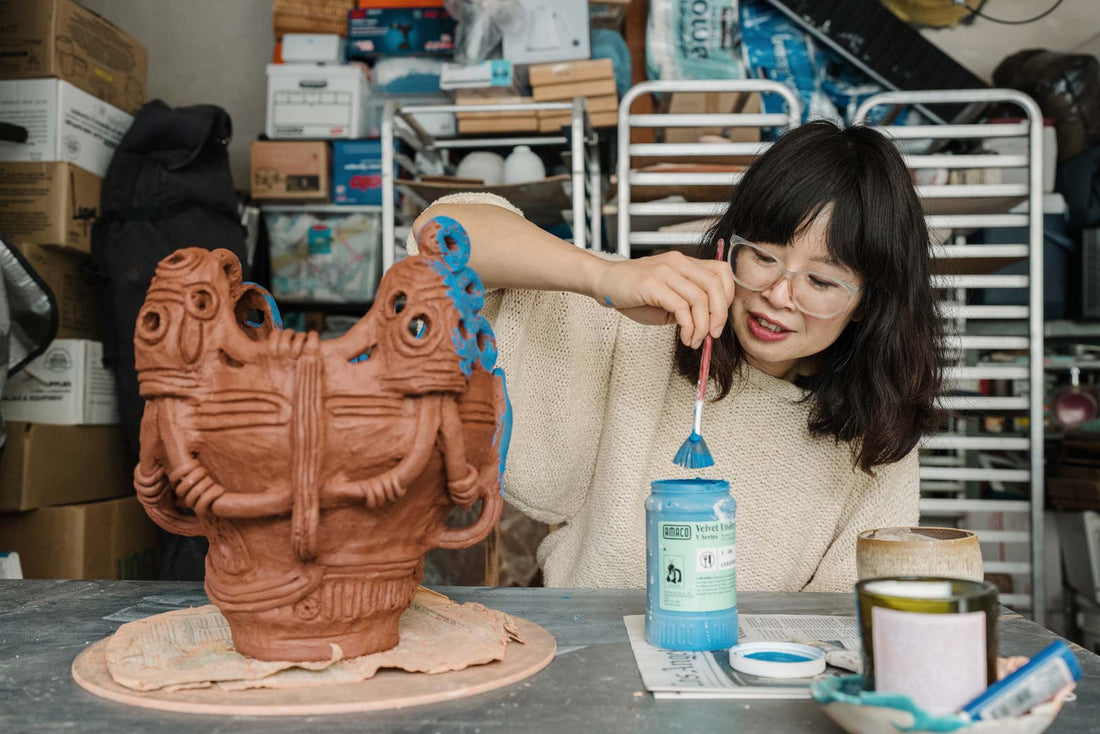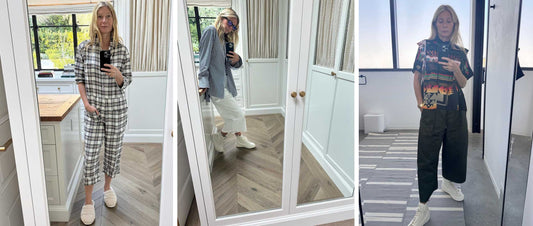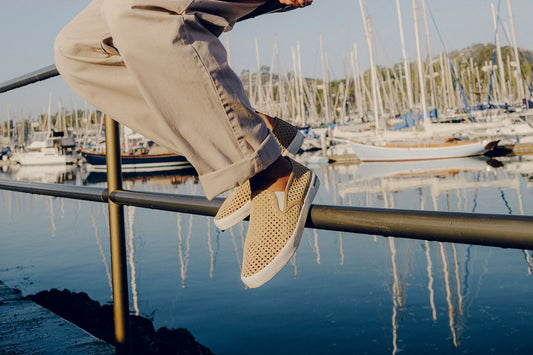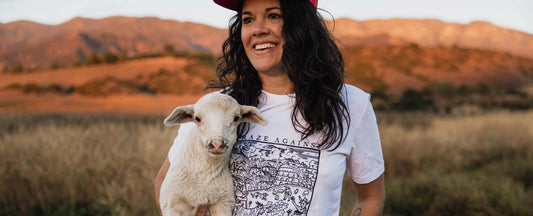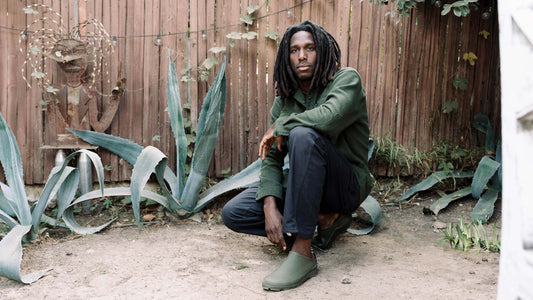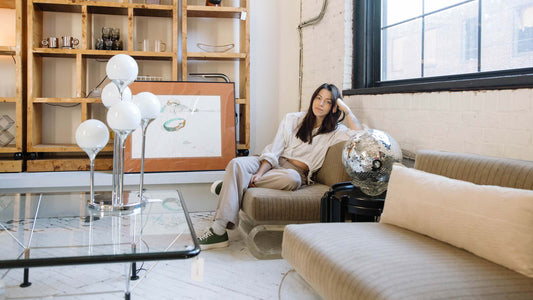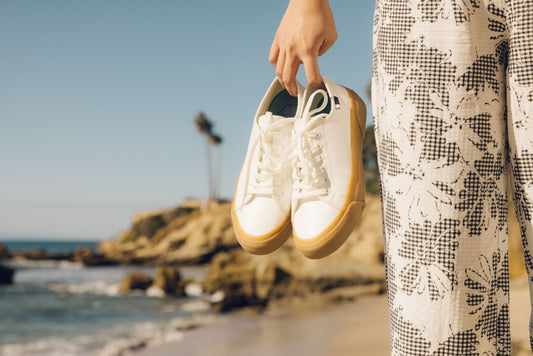Raina Lee pulls a sheet of plastic off a damp clay pot with the showmanship of a magician's assistant and sits down to apply a coat of blue glaze. Over her head, bikes dangle from the ceiling. There’s a table piled haphazardly with plastic buckets and used sponges. Outside, a chorus of birds ushers in the warm sunlight spilling across the concrete floor.
We’re in a garage in Los Angeles. That’s what you’ll need to remind yourself of if you happen to catch a glimpse of the shelving unit behind the artist. It looks more like a cabinet of curiosities you’d find on another planet, a display of moon rocks, otherworldly shells and alien organisms that are actually, upon further inspection, just the vases and bowls Raina makes here in this single-bay garage.
“Some of my friends have a fear of holes and they’re terrified of my work,” laughs Raina. “They’re like, ‘I’ll buy your normal stuff but keep that vase away from me.’”
In the age of fitting everything you do into a tagline, Raina has remained a multi-hyphenate. And it’s her plethora of interests — from videogames to history class — that inspire her dream of creating commissioned, large-scale ceramics for clients who prefer the unexpected.
Words by Raina Lee, as told to SeaVees. Photography by Johnie Gall.


“I used to be pretty punk rock, if you can believe it. During college, I printed zines about bands, feminism and videogames through the lens of how people relate to technology. One contributor had gotten into an accident that left him paralyzed except for his thumbs, and he spent five months mastering Tetris. Another was a prison inmate who drew an elaborate architectural plan for an imaginary arcade based on every game he had ever played as a kid. Videogames give people another place to exist and learn to relate to the world. They’re also sexist as hell [laughs].
My parents are from Taiwan, and they owned a pizza shop, so growing up I’d spend a lot of time playing arcade games in the front of the restaurant — I was very popular because I was always the one bringing pizza to sleepovers. I guess I had the dream childhood: all-you-can-eat pizza and video games. After college, I started working as a writer in the gaming industry. Then I worked in public relations, at a large advertising agency, at some point I wrote copy for Apple. It was fine and I never disliked it, but it didn’t feel like real writing, you know?
“I guess I had the dream childhood: all-you-can-eat pizza and video games.”
I published a book on karaoke called Hit Me With Your Best Shot which is full of techniques and tips for karaoke. I had actually been trying to sell a book on gaming which is hard to do, so my agent asked if I had any other ideas. Growing up, all of my parents’ friends had laser-disc karaoke machines in their living rooms. It’s a huge part of Asian culture and it wasn’t until later in life I realized all of my white friends were just starting to discover it. They sell the book at Urban Outfitters. So, outside of work, I was always making things but I never considered any of it art.

I only got into ceramics because I happened to live next to a studio in Brooklyn, so I would take a yoga class and then hop over to the ceramics studio. I started out just making cups and bowls and stuff, and then a friend invited me to rent space at a communal studio with 40 artists. Everyone there had other careers — one woman was a dancer, one was a 3D printer, one guy was a chef — but it was a space for serious practicing artists, people making ceramics that didn’t necessarily have a function. We’d all work our regular jobs and then at night we’d be in the studio.
“In the age of branding, I don’t have a tagline, I just want to try it all.”
I never set out to make work to sell. I don’t know if anyone really starts ceramics with that intention — you’re like, I guess I’ll make some cups for my house? Everyone gets a wonky bowl for Christmas! But at this studio they would host sales, and my work was obviously next to everyone else’s and some of it started to sell. Buyers were forced to look at my work, basically [laughs].


The piece I’m working on right now for a group show is totally weird. It’s based on a style of ceramics from neolithic Japan, maybe 10,000 B.C. It was a culture that was ocean-based, and a lot of their work incorporates rope and netting. It’s so fascinating because most of the ceramics before 15,000 A.D. were functional, used for agriculture and storage. But this particular culture, even though they were working and trying to survive, made pieces that weren’t functional. They made time to be creative which is so unusual. It has all these strange, elaborate rope motifs, a lot of texture — it looks like an alien made it, so in that way it’s my vibe [laughs]. I’m inspired by science fiction, videogames and the natural world: craters on the moon, geothermal pools in Iceland, the colors of the rocks in Nepal. In the age of branding, I don’t have a tagline, I just want to try it all.

I think that’s what’s so cool about ceramics: the technique itself hasn’t changed much in the last few thousands years. At the end of the day, we’re using the same methods and glazes you’d find in ancient China, and pottery lasts in the ground. Ancient Greek pottery survived, work from the Song dynasty and Persia made it through wars. People have clearly loved making things with their hands for a long time — most of the people I know who took up ceramics did it because they wanted that contrast from working in an office. I know I was sick of reading blogs! We’re all sick of the Internet. We just want to get our hands in some dirt.


This is the first year I’m doing ceramics full-time, which for me, really just means taking on less freelance work. It’s more of a slow build than a leap, but it’s exciting because I was never a visual artist before. With writing, you’re always editing and then sometimes your story gets killed and, sure, you get paid, but it never gets published. With ceramics, I’m still shocked I can make something and it’ll sell.
“Anyone I know who is popular on Instagram struggled for years, yet it’s a weird fairytale Instagram tells us.”
I’ve spent hundreds of hours and thousands of dollars marketing my work and schlepping it to tradeshows — you can’t just put art into the world and expect to sell it. They don’t teach you that in art school. Anyone I know who is popular on Instagram struggled for years, yet it’s a weird fairytale Instagram tells us. I knew I didn’t want to do wholesale work because that meant mass producing hundreds of the same item over and over, and if you make your own pieces, you can’t do that for such a small profit margin. Every artist I know does whatever it takes to sell the work. That’s kind of a comforting idea though, knowing you don’t have to be particularly amazing at art to be successful as long as you put in the work.

My partner and I bought this house in 2013 and it came with this treehouse, upper deck, and a wooden boat for kids to play in. The previous owner worked as a theater professor, so it’s all made from wood reclaimed from old theater sets. My partner found the shelves in a dumpster and the trunks are from random trees around the property. My pottery was overflowing in the house and I’d have to drag it out every time a friend wanted to come over and buy something, so I put it up in the treehouse. Now people can come for holiday sales, drink some tea, and walk away with this whole experience.
Once photos of the treehouse got out there, people started saying I’m living this dream life and that’s true in that I’m doing what I want for a living. It’s so much harder than having a “normal job” though, and it’s not the rosy picture people have in their heads. But as long as my time is being controlled by me, I think that’s the dream. It’s a dream when I’m making work someone appreciates. I’ve had some very unusual customers that are shocking to me — there’s a celebrity that bought a few pieces! If someone liked my work enough that they would commission a piece and give me complete creative control because they trust I’d make it interesting, that would be the ultimate dream come true.


I don’t think there’s ever going to be a moment where I feel like I’ve mastered ceramics. Clay dries and cracks and warps and it doesn’t act how you want it to. Besides, there are so many glazes and styles and this deep history to dive into! I make my own glazes to try and get different textures, which is pretty unconventional. I’ll see greens and purples in a shell and realize that when I’m firing a piece it’ll flash the same colors and that’s because there’s a similar oxidation process. There’s chemistry involved. Lately I’ve been firing pieces with horsehair, which is a Native American technique that results in some really wild patterns. Sometimes I go in too many directions and have to pull it back in, but I’m so interested in weird occurrences and natural phenomena. Ceramics is basically taking rock and making it into something else, so we’re kind of recycling. I’m interested in trying everything, and I don’t think that will ever change. I have style ADD [laughs].”

